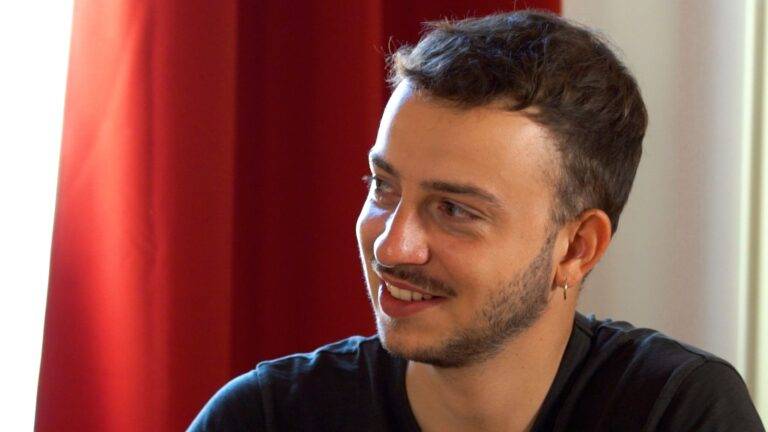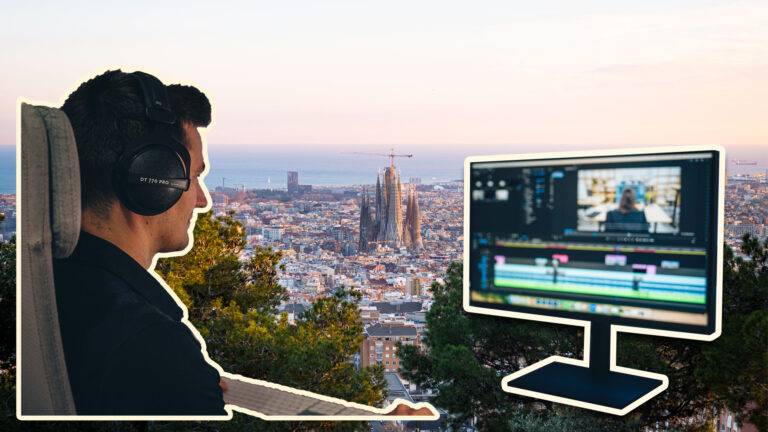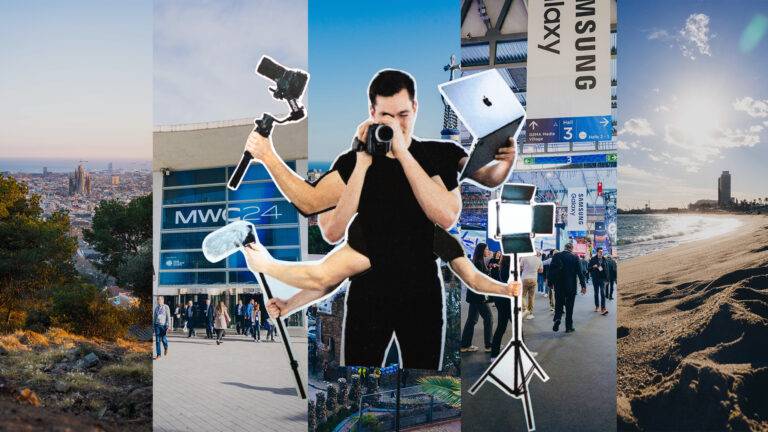
What happens once you created your video content?
The video production doesn’t stop there, as these videos are usually made to attract new customers.
This is exactly the role of marketing and of an acquisition marketer.
Learn all about Marketing Acquisition in this interview with Axel.
1. Intro
Axel is working in acquisition marketing for Audible, the audio company owned by Amazon. Before, he’s been working in the startup environment for a bit more than three years.
“What I love about it (marketing acquisition) is that it’s connected to so many media at the moment, and it’s important to have great knowledge about those media and about the ad placements that are on it. I’ve been working on that, putting up campaigns, ads, creatives for two years now, trying to get as many people to convert as possible.”

2. It all stems from having one campaign
How does your job look like? You get assets and you push them to achieve specific KPIs, right?
Yes. It’s exactly this, but this is only part of the process, to receive the assets and to push them. Because this is implemented into a wider campaign.
The idea comes before actually producing the assets. It all stems from, from having one campaign with one objective for a certain period over a certain media.
Once the campaign is defined, that’s when it comes to the targeting. Which people are we going to target? Which audience do we aim at? And then regarding all those rail guards that we put, these boxes that we ticked, then the assets are being produced depending on the requirements and the objectives of the campaign.
And depending on the specificities of the formats. It’s not going to be the same video for an Instagram story, as it’s going to be for a YouTube video. And even amongst specific networks, like YouTube, there are plentiful of different formats with specific requirements and also better fitting certain objectives.
So, it is getting assets and pushing them. But before that, there are many parameters to consider that shape the content production before then being pushed and achieving those objectives.
3. Automation
If we produce something for an Instagram Story, we sometimes recut the Photoshop file to have a square for a feed ad or something horizontal for YouTube for example.
When it comes to automation, there’s also beyond that many possibilities. For example, product feeds. You probably have seen on Facebook, the carousels ads with different squares. Those are basically just a CSV file,an Excel files with columns. One about the title, one about the item, one about the price, and one is going to be the image link. And it’s thousands of lines of image links.
Let’s say for a clothing retailer. It’s going to be thousands of lines of items and thousands of lines of images. And this is going to be pushed by Facebook. With all those data collections on you, if they know that you love sandals, for example, then the product images that are going to pop up, are going to be sandals.
This process is completely automated within the algorithm. Beyond that you can also add automation on the automation. So, let’s say those image lines, if you want to add on top the ratings of the items. You can automate to have four little stars on top of your little product image, but that’s a third-party tool that comes in the middle of the CSV file to automate the automation and push it on the networks.
So you can get quite complex. But once this automation and everything automation related, once the setup is done, you’re good to go.
4. Videos vs Images vs Texts
I would say that video is pricier than images, especially considering Google ads. However, it brings a lot more results, a much wider reach and more reactions from your targets. And if you think about our daily lives, I mean, we use Instagram, we use YouTube, we are more reactive to everything that has sound and video.
I would definitely say that video is the future more than images, even though, you cannot just cope with just one and not do the other. So if I had to keep just one that would be video because, it corresponds more the usages of nowadays. There are also many different formats for videos, which can fit different objectives.
Let’s say, for example, you want to target a very wide audience and just give them a bit of awareness about your product:
There’s one specific format called the bumper ad on Google ads. It’s six seconds, and this is going to be pushed to many, many people, and they will not be able to skip it. If you manage to be creative within six seconds, you can give awareness about your product on the upper funnel, to many people around the world or in the country you’re targeting.
Then if you have an objective lower in the funnel, let’s say you want people to sign up on your website, sign up on your app, you can have different formats that are a bit longer, 15 seconds for ex. Let’s say you target them in the story ads, they’re already aware of your product from the six seconds’ bumper.
They’re on Instagram and they see you again and like “oh, wow, that was cool. Maybe I’m going to install the app.”
If you want to get even lower in the funnel, let’s say a purchase of clothes or sign up to a membership, then you can also have a different format, more tailored. The campaign is also going to be shifted towards that objective.
However, it can sometimes share the same asset. Let’s say you have a campaign for people to sign up on your website. It can be the exact same asset as another campaign whose objective is to make you purchase.
Because the same assets can have different objectives in a campaign. The machine learning, doing it’s dumb, but smart job of rushing towards the objective is going to be different. The objective of the first is to collect as many people logging in as possible and the other one wants as many people as possible to make a purchase.
So sometimes assets can be shared between objectives. It’s always a matter of mixing the right asset with the right setup. It’s a bit of a mix and match.
5. Hypothetical Scenarios
Scenario 1:
Bootstrapping – Fresh Start-up, Low Budget.
I would say the first thing that is really important is to have an organic presence. At the beginning, you’re not going to know your audience perfectly. You have your target audience, but is it the one that’s actually responding? You haven’t tried it yet, so I would start with organic presence because it’s cheap and it’s tangible. When people look for you, you need to have something. Because if you put an ad and there’s nothing behind when people click on you, it’s not going to work. So you have to have solid ground. An organic presence on Facebook, Instagram, a website.
Then when it comes to paid acquisition, I would recommend to protect your brand name via keywords and paid search activities. Because that’s the way to really rise up to the top.
Let’s say you just start and you’re called, pear company. When people are going to type pear company, they’re not going to see you necessarily, unless your website is SEO optimized and Google’s algorithm loved it and pushed you to the top. And even then, paid search is always going to come on top.
So if you protect your brand name, you’re going to be on top and you’re sure that if anyone heard about you, is going to look for you, they’re going to see you.
Then you can collect some data, understand a bit better your audience. If they allow cookies, you can see who’s coming, where they went. And from that on you maybe have a better idea of who they are. And then you can maybe unlock some budgets to try some specific paid social ads, et cetera.
But I wouldn’t recommend starting straight up directly with an Instagram story. There’s a bit of work to be done before to have something tangible, because ads are just a medium to lead people somewhere. But if they cannot be led anywhere, it doesn’t matter.
Scenario 2:
SME – Some Budget, New in “digitalisation”.
At this stage, I would say they have enough data and enough knowledge about the audience prospects, who they want to attract. Basically, there’s going to be a lot of brainstorming needed to prepare the campaigns, define the budgets. They’re going to have to check with the managers and the finance team, how much budgets they have, what return they aim. Not necessarily money, it can also be sign ups, clicks. What are they aiming to get out of that?
In parallel, they have to order the assets, to receive them at the launch. They also need to set up the accounts. Overall, a lot of preparation and roadmaps are needed, to say that, for example “in two months we need to be at that stage. And we have to order this asset at this time, so we receive it on time”. It’s a bit like cooking in the end. You have to start with something, leave something on the side, so that at the end, everything is ready.
Scenario 3:
Established SME – With Budget, who wants to get bigger.
Yes of course, the larger the budgets, generally (except if you make a lot of mistakes) you’re going to get more impressions and therefore, statistically more reactions on your impressions and more data points to collect. So your campaign is going to be better optimized. The more info they get, the better it is and to get more info, you need to show your ads more.
So I would say for that thing, budget is hybrid. It’s always useful, but it’s not completely the key. You can make a lot of mistakes and pay a lot of money while you could have paid less.
What is also nice with more budget, is to resort to external agencies, specialized in paid advertising. (Not necessarily only for content, but for campaign setup)
And they basically act like consultants, and they can analyze what you prepared, what you’ve done. And usually those agencies have a lot of clients themselves so they can compare. And that’s the most important added value of those agencies, they can compare your business with all the businesses they’re working with and find synergies within that. Of course, they’re going to get learnings from you that they’re going to apply to other clients, but that’s the game.
6. In a nutshell – a continuous process
The start would be like this: Know who you are, who you want to be and who your audience is going to be. Who you are going to target is also being shaped by the different networks that you think are fit.
Then is all these operational parts, setting up the accounts and preparing the assets. And I would like to stress and highlight that this is really a continuous process. When you’re live, you’re going to have insights that you never thought you would have. Realizing that the people that convert more are not your planned target audience.
So I would say flexibility and willingness to adapt is key. At the same time do to not adapt to everything. If suddenly on your first week, you have more people from that target audience, don’t completely change your business model, but make sure to be flexible.
Wait for the right moment, but don’t over prepare because no matter how much you engineer it, it’s never going to be perfect, and you will have to adapt.
SHARE THIS POST


